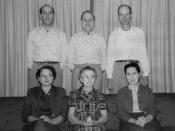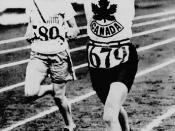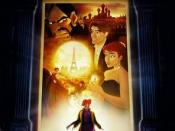The arrival of a journey is not as significant as the journey itself. Without considering the journey, the arrival would mean nothing. A journey is more than a movement from one point to another, it is what happens during the journey to an individual that matters, and the arrival is just the outcome of the process of development. Animators Don Bluth and Gary GoldmanÃÂs cartoon movie ÃÂAnastasiaÃÂ (1997) conveys how journeys arenÃÂt straightforward and can have many detours. But, the documentary ÃÂWho Do You Think You Are?ÃÂ (SBS 2008) featuring Jack Thompson deeply explores how journeys can have significant impacts on people who a somewhat linked to them, be it present or future.
Bluth and GoldmanÃÂs animation ÃÂAnastasiaÃÂ depicts choices an individual may have to make on a journey and how journeys may be influenced by curiosity and the need to seek knowledge. At the beginning of the film Anya (Anastasia), the main protagonist, comes across a fork in the road and she has two choices - go left and work in a fish market for the rest of her life, or go right to Saint Petersburg to catch a train to Paris and search for her family.
This shows how journeys are always full of choices and how we are always forced to choose between different ÃÂpathsÃÂ to take. When Anya decides to take the path on the right, she feels anxious as she realises that sheÃÂs deciding to leave her familiar environment to go to a foreign one, but then she feels anticipation because she knows that by taking this path there is a chance in finding her family or people who may know of her past. AnyaÃÂs anxiousness turning into anticipation is represented in the song she sings whilst walking down the chosen path, the rhythm is slow at the beginning (giving a feeling of uncertainty) but gradually becomes faster (giving a feeling of faith and self-confidence).
On the other hand, journeys have many detours and obstacle that may negatively affect an individual mentally and/or physically. Bluth and Goldman uses deception as the main obstacle in this film by having two other main characters, Dimitri and Vladimir, as con-artists trying to deceive the Empress Dowager in order to receive the reward money for restoring Anastasia to her, Anya becomes mislead and unconsciously becomes part of their con. When Anya discovers this, she becomes furious, loses motivation to search for her family and begins to pack her things. While Anya was packing her things, she finds a rose that she had when she was in Paris with Dimitri before she found about his plans, after having one last look at it she tosses it into the bin and resumes her packing. This shows us that she wants to go back to the fork in the road and forget everything that has happened, but she doesnÃÂt realise that it is impossible to return to the start and be that same person when she started.
The first episode of the SBS documentary ÃÂWho Do You Think You Are?ÃÂ with Jack Thompson depicts how an individualÃÂs journey can have an impact on other people and how going on a journey can be about new discoveries. In the first scene of the documentary, there is a car driving on a wavy road going through vegetation in a foggy atmosphere that is seen behind barbed wire. The car represents the traveller, in this case, Jack Thompson; the wavy road represents how journeys are never straightforward; the foggy atmosphere represents the unforseen in a journey; and the barbed wires represent obstacles and barriers that the traveller will have to overcome and may also represent that journeys can also be very hostile. At the start of the documentary, Jack Thompson knows nothing about his real family apart from that one of them, his great grandfather, owned a cedar farm and a tavern, and coincidentally, he also owns a cedar farm and runs a pub with his eldest son. ÃÂI am a product of my ancestry, although I do not know what that ancestry is.ÃÂ was one of the first sentences that Thompson quotes as he goes on a journey that he has no idea where it will lead him to, this emphasises the idea that ÃÂit is the journey not the arrival that mattersÃÂ as Thompson is being influenced by the curiosity on what he will learn by undertaking the journey to his past.
As Thompson progresses to places in the documentary, the train seems to be the main mode of transportation, this may represent that journeys are all about transitions of values and the sharing of knowledge, and it may also represent that Thompson is forging another chapter into his journey. When Thompson finds out that his great grandfather, Patrick Byrnes, owns a cedar farm and tavern like himself, he feels a deeper bond forming between himself and his ancestors. Another idea related to journeys is highlighted when Thompson learns more about Patrick Byrnes and travels to Ireland. Thompson learns that his great grandfather came to Australia as a convict, his crime being highway robbery, this highlights the idea that ÃÂoneÃÂs journey has the potential to affect othersÃÂ and reinforces the idea that journeys arenÃÂt straightforward and can be full forks, this also echoes the first sceneÃÂs foggy atmosphere. In the end, after reassessing on his own identity, Thompson calls himself the keeper of the familyÃÂs secrets - the patriarch, this wouldnÃÂt have been possible if Thompson didnÃÂt undergo the journey, he wouldnÃÂt have acquired the knowledge to make him so confident to call himself the patriarch of the family. Therefore, with his newly acquired knowledge, he has become a different person than he was at the start of the documentary.
Journeys offer chances for individuals to acquire new experiences and knowledge that they havenÃÂt yet obtained. Although, some journeys may be filled with challenges and choices like in Bluth and GoldmanÃÂs film ÃÂAnastasiaÃÂ with deception being the main obstacle, obstacles can be have a very big impact on the individual, making them feel like give up on traveling the rest of the journey. On the other hand, some journeys may provide the individual with emotional and mental significance, for example - in ÃÂWho Do You Think You Are?ÃÂ, Thompson feels a greater connection with his past and his family due to his acquired knowledge in the end. Both texts graphically depicts how journeys can affect an individual in the end, positively or negatively and that journeys are unique to each individual. In addition, both texts depict how journeys may be planned, influenced by curiosity and be influenced by the need to seek knowledge. Furthermore, both texts focuses on grasping the importance of the process of development (journey) instead of the arrival.
BIBLIOGRAPHY*Anastasia film*Who Do You Think You Are? (SBS)





